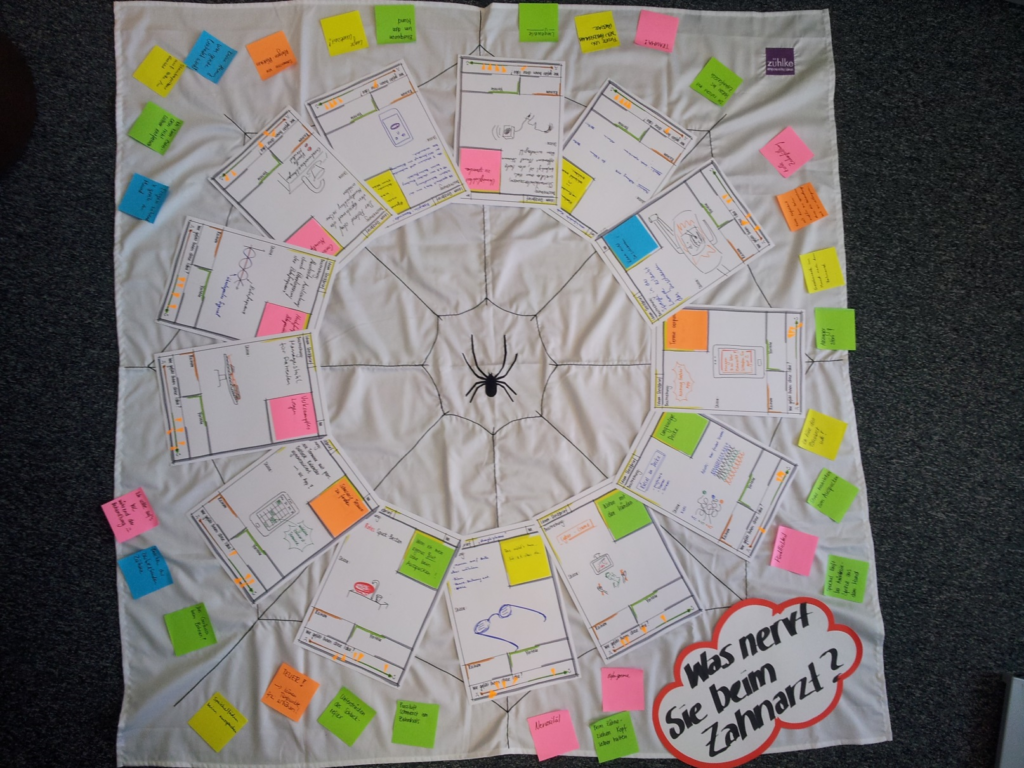Description
What is this technique about
Spider Meeting is a fun and interactive idea-generation and evaluation method for while concretising and evaluation of the ideas. It is a combination of brainwriting, pitching and sketching. The aim is to increase the level of detail of the ideas with the help of spinning the web from the outside in and at the same time to filter, i.e. to select the favoured ideas right away. A clear task is obligatory at the beginning. The spider technique is suitable for six to eight participants. Approximately one and half hour should be planned.
Where does it come from
The Spider Meeting method was inspired by the observation that in methods such as brainstorming, different teams come up with more or less the same approaches. The method basically combines brainwriting with idea concertising and evaluation techniques within the same workshop. Brainwriting differs from brainstorming in that, instead of getting people to discuss ideas out loud, it gets them to write them down and share them anonymously.
For which purposes it is used (why in your engineering teaching)
The Spider Meeting is used as a fun group activity for idea generation and detailing as well as idea evaluation. The outcome of the workshop is one idea, typically visualised by a sketch or a short story board.
How to use it
To begin the spider web exercise, draw a diagram with 6 to 8 segments, depending on the number of participants. Each person then writes down three to six ideas on post-it notes and places them in the corresponding segment of the spider web. The group then rotates around the table to review the ideas and each member selects two favorites. The chosen ideas are expanded upon with additional thoughts, and presented to the group to gather feedback.
The group then rotates around the table once more, and each person selects their preferred idea from the two that were presented earlier. This idea is further developed with sketches that demonstrate how the idea could work, preferably with a specific target audience in mind. This process results in six well-defined ideas, which are once again presented to the group. From these, one or two ideas are selected for further development in the creativity process.
Pitching works better because you don’t present your own ideas, but someone else’s. This makes the argument for the idea more credible and the other participants accept it more easily. All of a sudden, pitching isn’t about the ego, it’s about the ideas. The suggestions are then polished, analyzed and evaluated.
How to implement this techniques online
- Define a clear problem statement, for which solution ideas should be generated.
- Split the class in groups of six to eight participants.
- Depending on the group size, draw a spider web with six to eight segments and three rows.
- Make sure, that the participants have paper and pencils ready or working with a tablet and a sketching tool.
During application, i.e., while giving the session
- At the beginning of the exercise, each participant is assigned a unique color and a dedicated segment of the spider web to work with.
- The group generates ideas for a specific problem statement, with each participant generating up to six ideas. These ideas are then written down on digital Post-it notes and placed on the fields of the outermost row of the spider’s web. (20-30 Minutes)
- The group then rotates one segment of the spider web.
- The next participant reviews the ideas in the rotated segment and selects two favorites to expand upon with their own ideas and suggestions. (10 Minutes)
- The two favorites are presented to the group to gather feedback, which should be noted down. (20 Minutes)
- The group rotates one more segment of the spider web.
- The current participant selects one of the two ideas from their segment and sketches an improved variant of the idea with paper and pencil at home. A photo is taken and placed on a digital whiteboard. (20 Minutes)
- The group discusses and evaluates the final six sketched solutions.
Follow-up, about what to do after the session
- Identify the ideas that should be put in the next steps of the creativity process.
Examples and/or testimonials
Example Spider Web interim result from a workshop:
Tools needed
You will need a platform to share screens and communicate with the participants, such as: MS Teams, Zoom or similar.
You will also need a white board solution with digital sticky dots such as Miro or Mural:
- Zoom
- MS Teams
- Miro
- Mural
- Timer (phone, watch, computer)